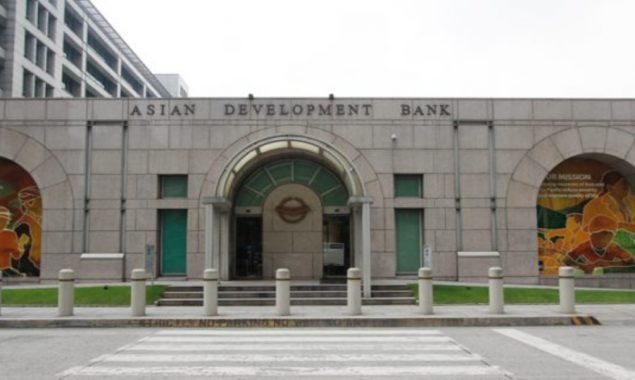ADB approves $385 million to improve health, living conditions in KP
ISLAMABAD: The Asian Development Bank (ADB) on Friday approved $385 million in...

Image: Business World
ISLAMABAD: The Asian Development Bank (ADB) on Tuesday projected higher inflation in Pakistan, compared with other regional countries and revised down the economic growth outlook for developing Asia slightly to 7 per cent this year and 5.3 per cent next year.
The ADB revised the projections after renewed outbreaks of the coronavirus (Covid-19) led to slower growth in the third quarter.
The ADB’s latest estimates, presented in the Asian Development Outlook (ADO) 2021, revised the forecasts, compared with the bank’s September forecasts of 7.1 per cent growth for 2021 and 5.4 per cent for 2022.
In the report, the inflation forecasts for 2022 have been revised up to 5.3 per cent from 5.1 per cent on similar expectations. Much of the forecast upgrade reflects a higher projection for Pakistan, where adjustments to energy tariffs and higher global commodity prices are expected to exert upward pressure on the domestic prices.
In the first five months of FY22, the Consumer Price Index already reached 11.5 per cent on a year-on-year basis.
However, the ADB said the growth prospects for FY21 and FY22 remain in line with the projections.
In Pakistan, cotton and sugarcane production increased with favourable weather, while services bounced back, as mobility tracking measures recovered beyond the levels in March 2020, before the pandemic outbreak.
The ADB had projected 4 per cent GDP growth in FY22, whereas the government of Pakistan’s own projection is that the GDP growth will go beyond 5 per cent.
The prospects for this year have been revised slightly downward for all subregions except Central Asia.
“Developing Asia’s steady progress in dealing with [the] Covid-19, through continued vaccination drives and more strategic application of containment measures, helped boost growth prospects in the early part of the year,” ADB acting chief economist Joseph Zveglich, Jr said.
However, new outbreaks in the third quarter muted gross domestic product growth, and the advent of the Omicron virus variant is causing renewed uncertainty. The recovery efforts will have to take these developments into consideration.
The main risk to the growth outlook remains a resurgence in the Covid-19 cases. The average number of daily cases globally rose to almost 573,000 on November 30, 2021 from 404,000 on October 15, 2021.
Developing Asia’s vaccination rate has increased significantly to 48.7 per cent (fully vaccinated) as of November 30, although the region still lags behind the United States at 58.1 per cent and the European Union at 67.2 per cent.
Rates of fully vaccinated people also vary widely within the region, from as high as 91.9 per cent of the total population in Singapore to as low as 2.2 per cent in Papua New Guinea.
Bucking the overall trend for developing Asia, Central Asia’s economy is expected to grow 4.7 per cent this year, reflecting higher commodity prices and increased public spending. The forecast for the next year has also been raised to 4.4 per cent from 4.2 per cent in September.
East Asia’s growth outlook has been downgraded 0.1 percentage points for both 2021 and 2022, to 7.5 per cent and 5 per cent, respectively, amid slight downward adjustments in the forecasts for the People’s Republic of China, the region’s largest economy.
China’s economy is now expected to grow 8 per cent this year and 5.3 per cent next year.
South Asia is forecast to grow 8.6 per cent in 2021, compared with September’s forecast of 8.8 per cent. The sub-region’s 2022 outlook remains at 7 per cent.
India, South Asia’s largest economy, is now expected to grow 9.7 per cent in the fiscal year 2021, which ends March 31, 2022. The reduction of 0.3 percentage points comes amid supply chain issues that are affecting industry.
India’s outlook for FY2022 is maintained at 7.5 per cent, as domestic demand is expected to normalise.
Southeast Asia’s 2021 outlook has been revised down 0.1 percentage points to 3 per cent, as economies in the sub-region imposed targeted restrictions in the face of the Covid-19’s delta variant.
The next year’s growth forecast has been increased to 5.1 per cent, as economies are expected to continue easing overall restrictions and reviving economic activities. The growth forecast for the Pacific is maintained at -0.6 per cent this year and revised slightly down to 4.7 per cent for 2022.
Regional inflation is expected to remain manageable at 2.1 per cent in 2021 and 2.7 per cent in 2022, allowing for a more accommodative monetary policy and supporting pandemic recovery efforts.
Catch all the Business News, Breaking News Event and Latest News Updates on The BOL News
Download The BOL News App to get the Daily News Update & Follow us on Google News.